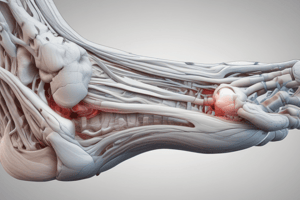Podcast
Questions and Answers
What type of joints are the metatarsophalangeal joints?
What type of joints are the metatarsophalangeal joints?
- Condyloid joints
- Pivot joints
- Spheroid joints (correct)
- Hinge joints
What is the range of extension for the 1st metatarsophalangeal joint?
What is the range of extension for the 1st metatarsophalangeal joint?
- 70 degrees
- 80 degrees (correct)
- 60 degrees
- 90 degrees
What is the main function of the ligaments and muscles that stabilize the interphalangeal joints?
What is the main function of the ligaments and muscles that stabilize the interphalangeal joints?
- To increase the flexibility of the foot
- To allow for a wide range of motion
- To provide an effective lever arm function of the foot (correct)
- To provide shock absorption
Which of the following bones does not contribute to the medial longitudinal arch of the foot?
Which of the following bones does not contribute to the medial longitudinal arch of the foot?
What is the highest point of the medial longitudinal arch?
What is the highest point of the medial longitudinal arch?
What is the main purpose of the arches of the foot being raised by the support of ligaments and muscles?
What is the main purpose of the arches of the foot being raised by the support of ligaments and muscles?
How many bones are present in the foot and ankle?
How many bones are present in the foot and ankle?
What type of joint is the talocrural joint?
What type of joint is the talocrural joint?
What is the primary motion occurring at the subtalar joint?
What is the primary motion occurring at the subtalar joint?
What is the function of the ligaments connecting the backfoot to the midfoot?
What is the function of the ligaments connecting the backfoot to the midfoot?
During subtalar pronation, what happens to the tibia and talus?
During subtalar pronation, what happens to the tibia and talus?
What is the function of the tarsometatarsal (Lisfranc) joint?
What is the function of the tarsometatarsal (Lisfranc) joint?
Flashcards are hidden until you start studying
Study Notes
Metatarsophalangeal Joints
- Metatarsophalangeal joints are classified as condyloid joints.
- The 1st metatarsophalangeal joint has a range of extension of up to 70 degrees.
Stabilization of Interphalangeal Joints
- Ligaments and muscles stabilize the interphalangeal joints primarily by preventing excessive movement and providing structural support.
Medial Longitudinal Arch of the Foot
- The fibula does not contribute to the medial longitudinal arch of the foot.
- The highest point of the medial longitudinal arch is located at the navicular bone.
Purpose of Foot Arches
- The raised arches of the foot, supported by ligaments and muscles, serve to distribute weight, absorb shock, and enhance balance and stability during movement.
Bone Structure of Foot and Ankle
- There are a total of 26 bones present in the foot and ankle.
Talocrural Joint
- The talocrural joint is a hinge joint, allowing primarily for dorsiflexion and plantarflexion motions.
Subtalar Joint Motion
- The primary motion occurring at the subtalar joint is inversion and eversion of the foot.
Ligament Functionality
- Ligaments connecting the backfoot to the midfoot help maintain foot structure and provide stability during movement.
Subtalar Pronation Dynamics
- During subtalar pronation, the tibia internally rotates, and the talus moves down and medially.
Tarsometatarsal (Lisfranc) Joint Function
- The tarsometatarsal joint plays a key role in transferring weight from the hindfoot to the forefoot and maintaining foot stability during movement.
Studying That Suits You
Use AI to generate personalized quizzes and flashcards to suit your learning preferences.




